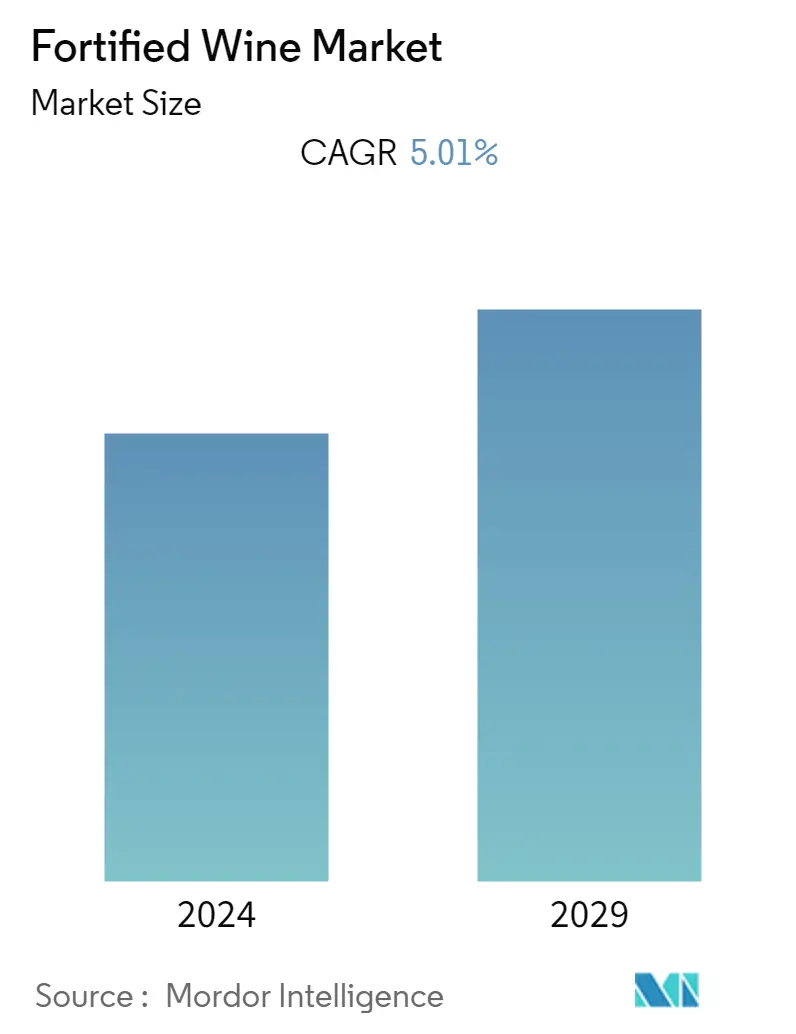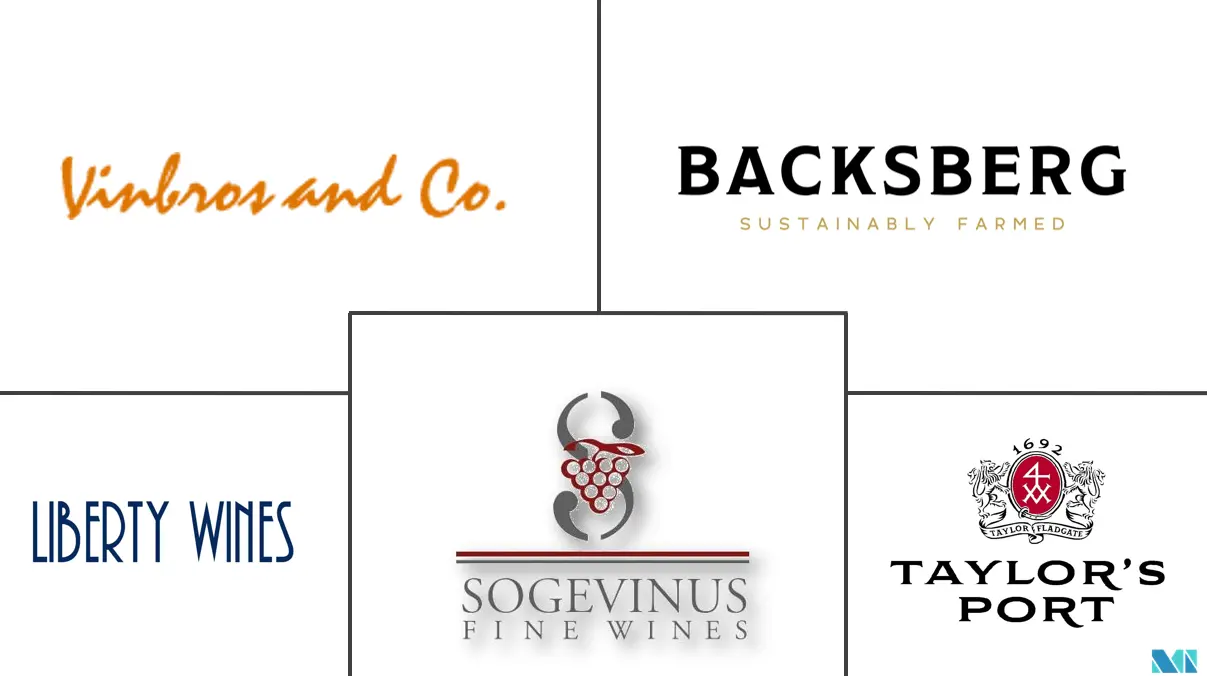Market Size of Fortified Wine Industry

| Study Period | 2019 - 2029 |
| Base Year For Estimation | 2023 |
| CAGR | 5.01 % |
| Fastest Growing Market | Asia Pacific |
| Largest Market | North America |
| Market Concentration | Low |
Major Players
*Disclaimer: Major Players sorted in no particular order |
Fortified Wine Market Analysis
The global fortified wine market is expected to register a CAGR of 5.01% over the next five years.
- The fortified wine market is especially driven by the growing trend of alcohol consumption in developing countries. The growth of the fortified wine market is also affected by seasonal variations, owing to the production of grapes. Consequently, the prices of grapes also affect the prices of fortified wines. Many countries in the world produce fine wines of premium quality and fortification.
- According to the International Organisation of Vine and Wine data 2021, Italy produced about 50.2 million hectoliters of wine in 2021. Government regulations and rules can also play a significant role in supporting the growth of the fortified wine market. For example, some countries may have policies that encourage the production and sale of fortified wines or provide incentives for winemakers to experiment with new techniques and flavors.
- In recent years, the legalization of cannabis in North American states has led some market players to infuse it into wine, creating a new type of fortified wine that is higher in alcohol and has a unique flavor. This has attracted younger consumers in the region who are interested in trying new and innovative alcoholic beverages.
- Premiumization is a key factor driving the demand for fortified wine. With the rise in disposable income and a growing working population, consumers are increasingly opting for premium fortified wines over local brands. This trend is expected to continue in the coming years, especially in developing countries. In addition, young consumers are also driving demand for fortified wines with different flavors and alcohol types, as they are attracted to the variety and unique taste. This has led to innovations in the market, with wine producers creating new products that combine different types of wines, flavors, and alcohol to cater to consumer preferences.
- For instance, in January 2022, Maison Mirabeau launched its first vermouth in the United Kingdom, Rose Vermouth. Rosé Vermouth is described as an 'aromatic' apéritif that celebrates botanicals from the south of France. The 17% ABV expression was made using the surplus stock of Mirabeau's 2019 Vintage Prét-à-Porter cans of rosé
- Over the medium term, demand for fortified wines is expected to increase owing to the increased consumption of alcoholic beverages at parties and other casual occasions, and product innovations.
Fortified Wine Industry Segmentation
Fortified wine is a type of wine that contains distilled spirits and higher alcohol content than regular wine.
The market for fortified wine is segmented based on product type, packaging type, distribution, and geography. Based on product type, the market is segmented into port wine, vermouth, sherry, and others. By distribution channel, the market is segmented into on-trade, supermarkets & hypermarkets, specialty stores, and others. By geography, the market is segmented into North America, Europe, Asia-Pacific, South America, and Middle-East and Africa.
For each segment, the market sizing and forecasts have been done on the basis of value (in USD million).
| Product Type | |
| Port wine | |
| Vermouth | |
| Sherry | |
| Other Product Types |
| Distribution Channel | |||||
| On-Trade | |||||
|
| Geography | |||||||||
| |||||||||
| |||||||||
| |||||||||
| |||||||||
|
Fortified Wine Market Size Summary
The fortified wine market is experiencing significant growth, driven by increasing alcohol consumption in developing countries and a rising demand for premium products. This market expansion is influenced by seasonal variations in grape production, which in turn affects pricing. The market is also seeing innovations such as the infusion of cannabis into wines, particularly in North America, attracting younger consumers seeking novel alcoholic beverages. The trend of premiumization is prominent, with consumers opting for high-quality fortified wines, which are often associated with unique flavors and a sophisticated drinking experience. This shift is further supported by government policies in some regions that encourage the production and sale of fortified wines, as well as incentives for winemakers to explore new techniques and flavors.
In the United States, fortified wines are among the fastest-growing alcoholic beverages, with their unique flavors and higher alcohol content making them popular choices in cocktails and the food service industry. The emergence of single-spirit bars has boosted the popularity of antique fortified wines like sherry and port. Market players are responding to the growing consumer interest by launching new products and engaging in aggressive branding campaigns. The competitive landscape of the fortified wine market is dynamic, with companies focusing on innovation, mergers, and acquisitions to expand their portfolios and enhance market share. Key players in the industry are actively introducing new flavors and products to meet evolving consumer preferences, ensuring the market remains vibrant and competitive.
Fortified Wine Market Size - Table of Contents
-
1. MARKET DYNAMICS
-
1.1 Market Drivers
-
1.2 Market Restraints
-
1.3 Porter's Five Forces Analysis
-
1.3.1 Threat of New Entrants
-
1.3.2 Bargaining Power of Buyers/Consumers
-
1.3.3 Bargaining Power of Suppliers
-
1.3.4 Threat of Substitute Products
-
1.3.5 Intensity of Competitive Rivalry
-
-
-
2. MARKET SEGMENTATION
-
2.1 Product Type
-
2.1.1 Port wine
-
2.1.2 Vermouth
-
2.1.3 Sherry
-
2.1.4 Other Product Types
-
-
2.2 Distribution Channel
-
2.2.1 On-Trade
-
2.2.2 Off-Tade
-
2.2.2.1 Supermarkets/Hypermarkets
-
2.2.2.2 Liquor Stores
-
2.2.2.3 Other Supermarkets/Hypermarkets
-
-
-
2.3 Geography
-
2.3.1 North America
-
2.3.1.1 United States
-
2.3.1.2 Canada
-
2.3.1.3 Mexico
-
2.3.1.4 Rest of North America
-
-
2.3.2 Europe
-
2.3.2.1 United Kingdom
-
2.3.2.2 Germany
-
2.3.2.3 France
-
2.3.2.4 Russia
-
2.3.2.5 Italy
-
2.3.2.6 Spain
-
2.3.2.7 Rest of Europe
-
-
2.3.3 Asia-Pacific
-
2.3.3.1 India
-
2.3.3.2 China
-
2.3.3.3 Japan
-
2.3.3.4 Australia
-
2.3.3.5 Rest of Asia-Pacific
-
-
2.3.4 South America
-
2.3.4.1 Brazil
-
2.3.4.2 Argentina
-
2.3.4.3 Rest of South America
-
-
2.3.5 Middle-East and Africa
-
2.3.5.1 United Arab Emirates
-
2.3.5.2 South Africa
-
2.3.5.3 Rest of Middle-East and Africa
-
-
-
Fortified Wine Market Size FAQs
What is the current Fortified Wine Market size?
The Fortified Wine Market is projected to register a CAGR of 5.01% during the forecast period (2024-2029)
Who are the key players in Fortified Wine Market?
Liberty Wines Limited, Backsberg, Taylor's Port, Grupo Sogevinus Fine Wines and Vinbros & Company are the major companies operating in the Fortified Wine Market.

